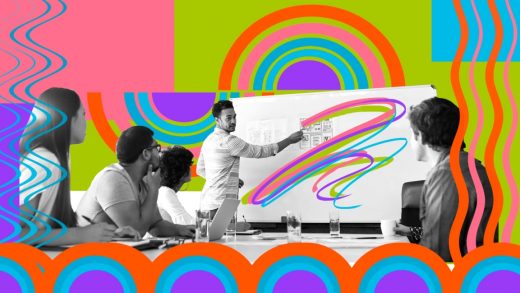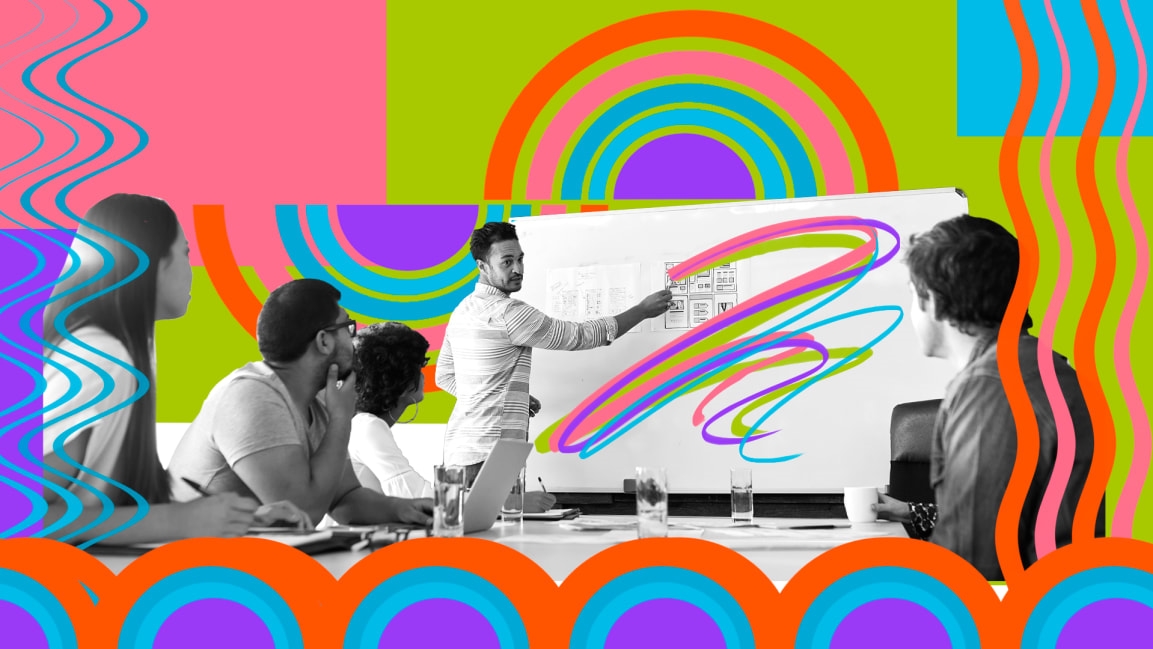6 tips that will help you work better using art activities (even if you can’t draw)
That’s because many of us in the business world have been programmed to think linearly. We don’t see ourselves as artists and spend most of our time working with the rational mind.
Our rational mind is designed to make decisions based on past events. It uses data points from previous experiences and predicts from there what could happen. However, the mind keeps us in somewhat of a loop; it limits possibility by sourcing ideas from what is already known.
If we want to escape old patterns and dated solutions, we have to birth our ideas in an open space called the zone of infinite possibility. Playing with art is a great way to stop boxing in our ideas because it overrides the left brain’s tendency to make sense.
Overthinking doesn’t make us smarter. It’s quite the opposite. When we let ourselves draw, color, paint, or mold—we start to think outside the box. In fact, we’re not thinking linearly anymore. Instead, we’re using our imagination and impressions from our bodily senses to access new realities.
Perhaps our artwork will confirm that art isn’t our true passion. And we may not find ourselves hanging our project on the dining room wall. However, it’s the process of creating art that provides so much value, and, regardless of how the end result looks, the piece will reveal surprising insights about us.
Art is a right-brained activity. Artists are encouraged to break rules and stretch boundaries. They are trained to play with perspective, expand their imagination, and develop a unique style of expression.
Art can teach us a lot and help us business professionals get what we really desire from our careers. It can boost innovation and our capacity to bring forth new ideas. It can align those of us who feel disconnected from our passion or are seeking to build our own brand.
Because we business professionals aren’t typically trained in the arts, we tend to look outside ourselves, often at the competition, to find our uniqueness. This strategy undercuts our ability to differentiate our creative gifts, and we get lost in the crowd.
Implementing artful communication at work
If you’re hesitant to use art activities in your workplace, consider this: It’s true that we live in a wordy world, but there’s been a major shift. Over the last decade, we have deepened our affinity for visual information. The use of infographics, emojis, and image-based social media is on the rise.
Why? Because the visual arts align with how we naturally (and more quickly) process information. They elicit emotions more effectively. And, as the saying goes, a picture is worth a thousand words.
Aside from providing a fun and refreshing change from the usual note-taking sessions and information rants, here’s what else you can expect from implementing art activities in your workplace:
People may find their voice. Those who normally struggle to express themselves in meetings may suddenly find their voice. Sometimes our intelligence lies dormant within us because the methods typically used to extract it don’t resonate with us.
New ideas will arise, quickly. Given that many of us have a lot going on in our minds, it’s often hard to express our thoughts coherently. Art can serve as a funnel that brings form to ideas we can’t yet articulate with words. It also provides an outlet for information that doesn’t yet fit into a linear chain of thought.
Intuitive hunches will surface. Art is a gateway to intuition, which is knowing something without knowing how we came to know it. Ask your team to draw possible outcomes of decision paths. You’ll be amazed at the level of accurate foresight that comes through.
Emotional balance is restored. Workplaces tend to overstress mental activity, causing us to suppress feelings. Art gives a voice to emotions that need to be surfaced in order to be resolved.
If you’re now starting to visualize using art in your work environment, here are six tips to help you turn this into a routine practice:
When we stand in front of a blank sheet of paper (or stare at a blob of clay), it’s amazing to see how much of our “stuff” comes up. All of our fears and false beliefs about creativity surface in an instant.
I call this “blank canvas anxiety.” For a brief moment, we love the freedom of being able to create anything at all. Then we are immediately overwhelmed. Rather than returning to the comforts of the left-brained world, we can zoom in on why the activity is triggering us.
Our art always says something about us. It reveals our genius perspectives but can also reflect how we hold ourselves back from success and sabotage our creative powers. These simple art projects provide an excellent opportunity to confront the creativity squelcher within us.
Art is a powerful yet underestimated tool that bypasses the traps of the rational mind and allows us to access our creative genius. So, the next time you or your colleagues feel creatively stuck and need more vibrance in your workflow—draw it out.
Bianca Finkelstein is an awakening coach who helps people realize their full creative potential.
(23)



